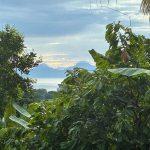 Some fortunate folks have been endowed throughout history with the awesome responsibility of ascribing common names to newly discovered avian species. Often, perhaps too often, these eloquent souls went above and beyond the call of duty in describing the palette of colors confronting them. That’s why we nature lovers have to go above and beyond to interpret just what these names actually mean.
Some fortunate folks have been endowed throughout history with the awesome responsibility of ascribing common names to newly discovered avian species. Often, perhaps too often, these eloquent souls went above and beyond the call of duty in describing the palette of colors confronting them. That’s why we nature lovers have to go above and beyond to interpret just what these names actually mean.
Our birding plumage of the day is rufous as in, “I caught a flash of rufous in that tree.” Rufous or, if you prefer, rufescent, is a reddish-brown color very similar to the color of oxidized iron. In fact, if you were unfamiliar with the term rufous, you would identify it as rust. However, rust is a hue more natural to a sword than a sabrewing, so rufous is often applied out in the field (not always, though, considering the plethora of plumage described as rusty.)
If you are at all interested in birds, get used to the word rufous. It is a very common color in the avian world. In the Americas alone, there are birds named for their rufous backs, bellies, breasts, brows, caps, cheeks, collars, crests, crowns, necks, napes, rumps, sides, tails, throats, vents, and wings. While there are perhaps 38 birds in the New World with rufous in their names, there are many, many times that number with rufous in their plumage. So, next time you go birding and spot the reddish-brown flanks of a towhee, call it like you see it. Call it rufous!
Of course, if that doesn’t work for you, there’s always ferruginous…













This reminds me of Australian writer Nick Earls’ novel ’48 Shades of Brown’. The teenage protagonist tries to comprehend the subtleties of the 48 different browns used to describe birds in Australia. (I can’t remember which field guide it refers to—but it is a real one.)
To be even more confusing, “rusty” is used in bird names as well: Rusty Blackbird, Rusty Lark, Rusty-cheeked Hornbill, Rusty-naped Pitta, Rusty-backed Thrush and others.
Mike, cool post. At the front of one of my field guides (I think it’s Costa Rica), there’s a whole section defining words like “Refuscent”, “Vermiculated”, “Fasciated”, “Fulvous”, etc. Those could be a future post for you.
You read my mind, Patrick. I’ve got a whole series planned. I invite you and everyone else to let me know which colors or patterns you find must interesting.
BTW, I’d bet money the field guide you’re thinking of is Costa Rica. You probably haven’t put it down for the last week!
You could probably do a whole series just on different ways of saying “brown.”
My favorite shade of rufous is ferruginous. That could just be because I fell off a cliff looking at my life ferruginous duck. 🙂
That’s awesome, Janet. I’m glad you survived the fall. I didn’t realize ferruginous was also in the rust family. I edited my post to include ferruginous, rusty (thanks, Birdfreak,) and rufescent.
John, you’re absolutely right. I’ll probably mix a little color in there, however, because I lack the talent to make 48 shades of brown interesting.
Hey, wonderful blog here and what a wonderful post! Keep up the great work!
because I lack the talent to make 48 shades of brown interesting
I’d strongly dispute that!
I enjoyed this post, especially when thinking of my first encounter with a ferruginous hawk and later attempts to remember and pronounce its name! It made me also think of how our love for words, birds and beauty overlap. In watercolor pigments as in birds, the language is not simple but imaginative. It’s not just blue but cerulean or ultramarine, not dark brown but sepia, not rust or reddish brown but burnt umber or burnt sienna. Language is fun. Thanks for the smile.
I really love this bird the rufous sided towhee. I saw my first one this week and looked him up in on the internet and was really offended that they trying to call him a spotted towhee. I say call all things by there proper name and you will know all things. His name should be the first characteristic that stands out about him and it’s those 2 damn rufous sides !!!!!!
Hi Jim. I know what you mean, but the Spotted Towhee is the western counterpart of the Eastern Towhee, both of which were once called Rufous-sided Towhee. I don’t think either name works particularly well, but I guess having to use Eastern Rufous-sided Towhee and Western Rufous-sided Towhee would be even less useful for birders and researchers?